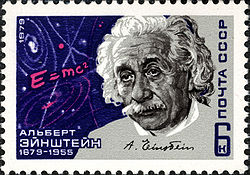
USSR postage stamp dedicated to Albert Einstein
The predictions of special relativity agree well with Newtonian mechanics in their common realm of applicability, specifically in experiments in which all velocities are small compared with the speed of light. Special relativity reveals that c is not just the velocity of a certain phenomenon—namely the propagation of electromagnetic radiation (light)—but rather a fundamental feature of the way space and time are unified as spacetime. One of the consequences of the theory is that it is impossible for any particle that has rest mass to be accelerated to the speed of light.

The speed of light in vacuum, usually denoted by c, is a physical constant important in many areas of physics. Its value is 299,792,458 metres per second, a figure that is exact since the length of the metre is defined from this constant and the international standard for time.[1] In imperial units this speed is approximately 186,282 miles per second.
According to special relativity, c is the maximum speed at which all energy, matter, and information in the universe can travel. It is the speed of all massless particles and associated fields—including electromagnetic radiation such as light—in vacuum, and it is predicted by the current theory to be the speed of gravity (that is, gravitational waves). Such particles and waves travel at c regardless of the motion of the source or the inertial frame of reference of the observer. In the theory of relativity, c interrelates space and time, and appears in the famous equation of mass–energy equivalence E = mc2.[2]
The speed at which light propagates through transparent materials, such as glass or air, is less than c. The ratio between c and the speed v at which light travels in a material is called the refractive index n of the material (n = c / v). For example, for visible light the refractive index of glass is typically around 1.5, meaning that light in glass travels at c / 1.5 ≈ 200,000 km/s; the refractive index of air for visible light is about 1.0003, so the speed of light in air is about 90 km/s slower than c.
These illustrations simply show two points and possibe interractions between them. More later.

General relativity or the general theory of relativity is the geometric theory of gravitation published by Albert Einstein in 1916.[1] It is the current description of gravitation in modern physics. General relativity generalises special relativity and Newton's law of universal gravitation, providing a unified description of gravity as a geometric property of space and time, or spacetime. In particular, the curvature of spacetime is directly related to the four-momentum (mass-energy and linear momentum) of whatever matter and radiation are present. The relation is specified by the Einstein field equations, a system of partial differential equations.
Some predictions of general relativity differ significantly from those of classical physics, especially concerning the passage of time, the geometry of space, the motion of bodies in free fall, and the propagation of light. Examples of such differences include gravitational time dilation, gravitational lensing, the gravitational redshift of light, and the gravitational time delay. General relativity's predictions have been confirmed in all observations and experiments to date. Although general relativity is not the only relativistic theory of gravity, it is the simplest theory that is consistent with experimental data. However, unanswered questions remain, the most fundamental being how general relativity can be reconciled with the laws of quantum physics to produce a complete and self-consistent theory of quantum gravity.